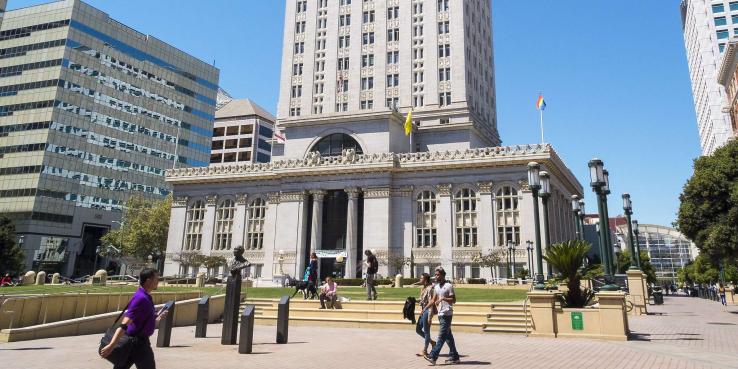July marked the beginning of the new fiscal year for the City of Oakland, and with it the end of a rancorous two-month-long adoption process for a new two-year budget. It all began in May, when, as required by the city charter, Mayor Libby Schaaf submitted her proposed budget to the City Council and Council President Rebecca Kaplan proposed an alternate budget. What followed was nearly two months of counterproposals, allegations, information and misinformation before the eventual adoption of a budget.
The mayor called her budget the responsible thing to do to help Oakland dig out of financial insecurity and recover its credit rating. The council president countered that the mayor’s proposal was too conservative and that the alternate budget would treat Oaklanders with respect and dignity as they sought to deal with rising prices, rising rents and rising costs. In response, the city administrator called the council president’s budget “too flawed to fix,” and Councilmember Larry Reid commented, “in my 22 years on the council, I’ve never seen a worse budget.”
While debate over values and budgetary priorities is the bedrock of city politics, the process can and should be bounded by a foundation in objective number crunching, something Oakland currently lacks. Without a city controller, a politically neutral role who ensures fiscal integrity and establishes a common set of financial facts for everyone to work from, the debate in Oakland is not only over which priorities to fund but whose numbers to believe.
The Mayor’s Proposal
The mayor’s proposed budget included major increases in expenditures on affordable housing construction, transportation infrastructure and repaving; new positions in the Fire Prevention Bureau; and the creation of the city’s first-ever homelessness commission. To pay for this, the mayor proposed annual expenditures of approximately $1.6 billion per year for a two-year total of $3.2 billion, a 15% increase over the last budget.
To those who have been observing the goings on in Oakland, especially downtown, it would seem that such an increase would be eminently affordable. But as the mayor noted in her budget letter, “though cranes are rising across the skyline and Oakland’s revenues are growing at a steady rate due to the strong real estate market, the city’s expenses continue to rise faster than revenues.” At a presentation of her proposed budget at SPUR, the mayor noted that the root cause of the expenditure problem is that personnel costs — including state-mandated retirement contributions — are causing Oakland’s general purpose fund expenditures to grow two to three times faster than revenue. For this reason, the projected two-year shortfall at the beginning of the budget process was $43 million.
City Council Pushes Back
While the Oakland City Charter assigns the mayor the responsibility of proposing a budget, it gives City Council the power to amend and approve it. In recent years this division of authority has led to proposals from councilmembers that amount to dueling alternate budgets. This year, Council President Kaplan’s budget was based on a very different set of assumptions about how much revenue the City of Oakland would take in — and what the city should be spending that revenue on.
Kaplan’s budget started from the premise that the mayor was too conservative with her revenue projections — $100 million too conservative. For her part, the Council President proposed eliminating Oakland’s still new Department of Transportation, cutting $7 million for the Oakland Police Department, increasing the amount that the Oakland spends on affordable housing and providing larger salary increases for unionized city workers.
The Final Resolution
In the end, the “Oakland Together” budget that the council finally and unanimously adopted gave Kaplan most of what she wanted and came in at $87 million more (over two years) than the mayor had asked for. The final budget rejected Kaplan’s proposal to cut the Oakland Department of Transportation, but it included most of her other requests, including $4.2 million for employee raises above what the mayor had proposed, with an option for a further $8 million — things that the mayor had insisted the city could not afford.
How did this budget go from “too flawed to fix” to unanimous approval? In the simplest terms, the new version was deemed balanced because the revenue projections on which it was based were deemed valid. Without financial data from an objective source, there was nothing to do but choose between the two proposals.
Whose Numbers?
Because Oakland’s budget adoption process was only two months long, there was little that could be done other than focus on how to cut expenditures and how to estimate revenues. But over the long haul, the City of Oakland will need to both grow its revenue base and rationalize its budgetary process. While SPUR has written about what Oakland can do to improve its economic situation many, many, many times, growth by itself won’t cure what ails Oakland. What must also happen, and maybe happen first, is a change in the way the city does business.
Unlike San Francisco and many other cities, Oakland does not have an appointed controller, someone whose job is to protect the city’s finances and act an impartial source of budgetary truth. Instead, the budget, like everything else, is a terrain for political battle. A robust civic dialogue about how to balance among competing priorities will generally result in a stronger budget plan. But tradeoffs among those priorities only make sense if there is a common understanding of the resources available.
